
Juan Fernandez Provisioning Locations Menu: 1 2 3 4 5 <<First
Golden Age of Piracy Provisioning - Juan Fernandez Islands Page 5
Juan Fernandez Food Descriptions, Continued
Other Seafood
Much of the meat on the Juan Fernandez Islands came from the ocean, although not all of it was fish. Conger eels (either Gnapthopis smithi or Gnapthopis parini) provided food for George Shelvocke's voyage from the island in October of 1720 because he discovered a way to preserve them which didn't require salt, something he neither had nor was apparently able to make.1 In the account of George Anson stopping there in 1741, Richard Walter also mentions catching conger eels.2
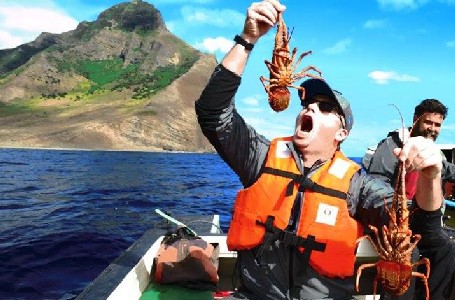
Image: Author - My Brother-in-Law Clowning with Jasus Frontalis at the Island in 2015
(Honestly, this was the only image of them that I could find which I had rights to use.)
One of the prized meats found there were lobsters, which all of the sailors identified as giant crayfish. These lobsters are Juan Fernandez Rock Lobsters (Jasus frontalis) which are endemic to the islands. Both Edward Cooke and Woodes Rogers mention eating them; Rogers says they caught them "in such abundance, that in a few hours we could take as many as would serve some hundreds of Men"3 and Cooke notes that they were "as good as our Lobsters"4. When George Shelvocke was shipwrecked on the island in 1720, he said that they ate "the largest craw-fish I ever saw"5. Walter gives the most vivid description during Anson's visit as being a "delicacy in greater perfection, both as to size, flavour and quantity, than is perhaps to be met with in any other part of the world: This was sea cra-fish; they generally weighed eight or nine pounds apiece, were of a most excellent taste, and lay in such abundance near the water's edge, that the boat-hooks often struck into them, in putting the boat to and from the shore."6
Another creature which served as food were the seals that were found on the beach. Upon first encountering them on Más a Tierra in 1684, William Dampier said:
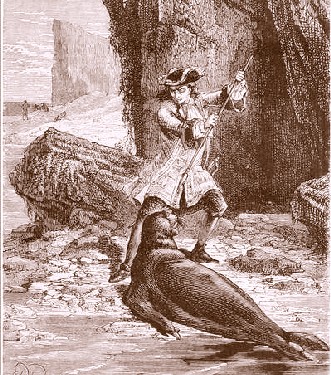
Anson killing a Seal on Juan Fernandez, From Les grands
navigateurs
du
XVIIIe siecle, By Jules Verne (1885)
"Seals swarm as thick about this Island, as if they had no other place in the World to live in; for there is not a Bay nor rock that one can get ashore on, but is full of them."7 At least one account talks about having to beat them away to even get on the beach.8
Seals (Arctocephalus philippii - the Juan Fernández fur seal) received mixed reviews as food from the various sailors accounts. When native Will was left on the island by the Trinity in 1681, he complained that "at first he was forced to eat Seal, which is very ordinary Meat"9. Sailor William Funnel said in 1704 that the seals "are very fat, but not the best victuals. …I have eaten of these Seals often, but it was to save better Victuals [for sea travel]; however they eat tolerably well, to those that are very hungry and have no other meat. The Lean of the Flesh is black, and of a course grain."10 Similarly, George Shelvocke reported after they shipwrecked that "necessity drove us to make use of seals; but [we] could not, for a pretty while venture upon their flesh, and therefore began by their entrails, which are really palatable."11 Woodes Rogers noted that his men killed the older seals "with a design to eat their Livers; but one of our Crew, a Spaniard, dying suddenly after eating ‘em, I forbad the use of ‘em."12 He elsewhere explains that "Men who work'd ashore on our Rigging eat young Seals, which they prefer'd to our Ships Victuals, and said was as good as English Lamb; tho for my own part I should have been glad of such an Exchange."13
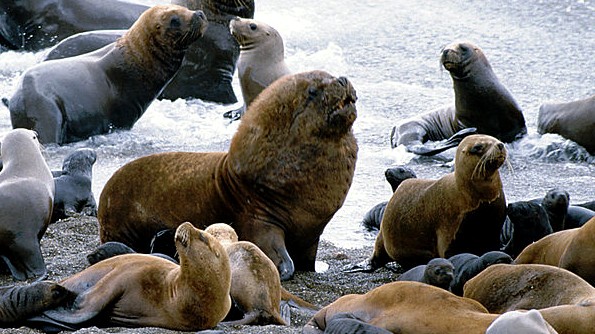
Image:Reinhard Jahn - Sea Lion Colony in Pategonia
The last sea animal discussed here was the South American sea lion (Otaria flavescens). Like the seals, they were very populous on the island. According to John Harris' summary of the 1624 journal of the Dutch Nassau Fleet, there were many thousands of both them and the seals on the beach. "Many of the Dutchmen fansied, that the Flesh of these Creatures [both seals and sea-lions apparently] tasted like Meat twice roasted or boiled; others were very well satisfied with them, and even affirmed that their Flesh... tasted as well as Mutton"14. Dampier said, "The lean Flesh is black, and of a course Grain; yet indifferent good food."15 During Ansons' visit, Walter said that they ate sea lions "under the demonination of beef"16 and, "We killed many of them for food, particularly for their hearts and tongues which we esteemed exceeding good eating, and preferable even to those of bullocks"17.
1 George Shelvocke, A Voyage Round the World by Way of the Great South Sea, 1726, p. 253; 2 Richard Walter, A Voyage Round the World by Way of the Great South Sea, 1726, p. 176; 3 Woodes Rogers, A Cruising Voyage Round the World, 1712, p. 131; 4 Edward Cooke, Voyage to the South Seas, 1712, p. 109; 5 Shelvocke, p. 253; 6 Walter, p. 125-6; 7 William Dampier, A New Voyage Round the World, 1699, p. 89; 8 Basil Ringrose, The Buccaneers of America, 1856, p. 252; 9 Dampier, p. 86; 10 William Funnell, A Voyage Round the World, 1969, p. 24; 11 Shelvocke, p. 243; 12 Rogers, p. 149; 13 Rogers, p. 132; 14 John Harris, Navigantium atque Itinerantium Biblioteca, A Complete Collection of Voyages and Travels, 1744, p. 72; 15 Dampier, p. 90-1; 16 Walter, p. 122; 17 Walter, p. 125
Meat & Fowl
Except for the first account of Dutch visitors from William Schouten's voyage, the only land-based animals used as food on Isla Más a Tierra were the goats which were likely placed there by the Spanish. Upon first sighting the island the account of Schouten's voyage reported that there were "many beastes, as hogges, and goates"1 Author Jacques Le Maire later explains that when they went ashore, the men "could indeed see numbers of fine pigs, goats and other animals, but impeded by the underwood they could neither stalk nor snare them."2 However, this is the only account to suggest there were meat animals other than goats on the island. If true, these may have been remnants of the two early Spanish settlements and they must have either been removed or died off before the arrival of the Nassau Fleet eight years later.
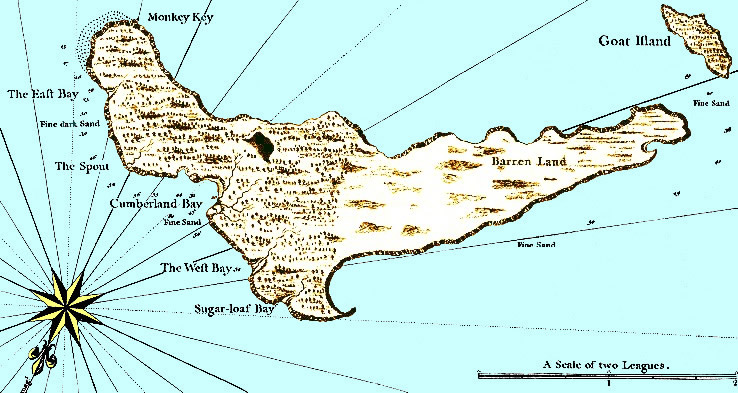 Map of Juan Fernandez Showing Goat Island, From A Voyage Round the World, By Richard Walter (1748) |
This brings us to the most often mentioned source of land-based meat on the islands - goats. Every account mentions hunting them and most of the early voyages talk about eating them. Goats were found on all three of the Juan Fernandez islands, apparently put there by the Spanish. Isla Santa Clara was even called Goat Island by some of the English visitors, as shown in the above map.
Image: Wiki User Lycaon.cl - Juan Fernandez Goat
On their arrival in 1684, William Dampier explained, "The Savannahs are stocked with Goats in great Herds: but those that live on the East end of the Island are not so fat as those on the West end; for though there is, much more Grass, and plenty of Water in every Valley, nevertheless they thrive not so well here as on the West end, where there is less Food and yet there are found greater Flocks, and those too fatter and sweeter."3 This was echoed by sailor William Funnell in 1704. He found that the island had "great plenty [of them], and especially towards the West part of the Island; they resort thither, by reason there is better Pasture for them."4 Woodes Rogers gave a different report, noting that they went to "the South End of the Island to get Goats. The Governour [Alexander Selkirk] told us, that during his stay he could not get down to that end from the Mountains where he liv’d, they were so steep and rocky; but that there were abundance of Goats there, and that part of the Island was plainer."5
The goats seem to have become more difficult to catch as time progressed which was why some of the accounts mention going to other parts of the island where they were more plentiful. There were many goats to be had according to the accounts of Basil Ringrose in 1680, Dampier in 1684 and Nicholas Simpson in 1689.6 By 1704, Funnell said there were plenty of goats, but he also said they had to go to a remote part of the island to get a large enough supply of them.7
Both Edward Cooke and Rogers seem to have been satisfied with the goats where they landed in 1709 for feeding the sick, although their accounts do not suggest that goats were a primary food source for everyone for the duration of their stay. They had the benefit of Alexander Selkirk's tame goats and ability to chase those in the eastern part of the island. Rogers mentions Selkirk catching two or
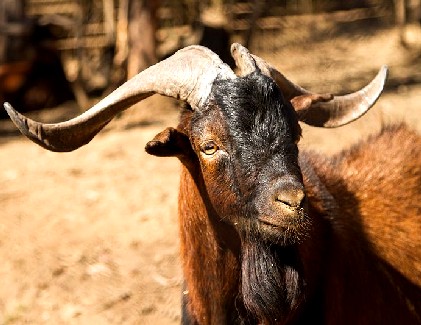
Image: Marcelo Jaime Diaz- Juan Fernandez Goat
three goats a day for the sick and, at the end of their stay, but for general supply, he sent a party to the remote West end where they could catch more goats.8 This was likely because, as Cooke noted, "those on the East End [were] not so fat as those on the West"9.
Nearer the end of the golden age of piracy in 1720, the shipwrecked George Shelvocke said, "as to goats flesh, that was hard to come at on several accounts", by which he meant the small amount of gunpowder and shot they had saved from the shipwreck and their lack of shoes making the goats' more difficult to pursue when they climbed upon the rocks.10 The fact that the goats ran for the mountains when chased is also stated in Jacob Roggevein's account of the Dutch stopping there in 1722. He adds that the ship's steward's mate of the one of his three ships - the Thienhoven - fell from a rock while chasing goats.11 By 1741, Walters reported that "the great numbers of goats, which former writers described to have been found upon this Island, are at present very much diminished"12. Observing the goat herds on Isla Más Tierra, Anson's sailors estimated the number of goat there to be about two hundred. On the other hand, Walters reports that Anson's crew found the goats on Isla Más Afuera easy to capture, not having been chased so often.13
None of the authors up until after the golden age of piracy give a very detailed description of the goats found on the island, suggesting there was nothing unusual about them. This should not be entirely surprising because they were originally domestic goats which the Spanish had placed on a variety of islands in the 15th and 16th centuries as a food source. However, Walter provides a rather poetic description of them during Anson's visit: "This was indeed an animal of a most venerable aspect, dignified with an exceeding majestic beard,
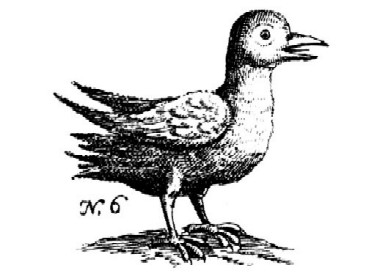
Edward Cooke's Drawing of a Juan Fernandez Petrel (1712)
and with many other symptoms of antiquity. ...we were so desirous of their flesh, which we all agreed much resembled venison"14. They are today called Juan Fernandez goats, being domestic goats which have reverted to the wild. They tend to be dark brown as seen in the images of them.
Buccaneer surgeon Lionel Wafer didn't usually provide a lot of detail about the food found on his late 17th century journey aboard the Batchelor's Delight, but he does spend some time describing a bird he found on Más a Tierra: the Juan Fernandez petrel (Pterodroma externa). He says it is "Grey, and about the size of a small Pullet [domestic chicken], that makes Burrows in the Ground like a Rabbit; lodging there in the Night, and going out to catch Fish in the day: For 'tis a Water-Fowl, and eats a little fishy, yet pretty well tasted after a little burying."15 Wafer said that the five marooned gamblers they picked up ate these fowls, among other things. When John Strong's ship Wager stopped at Isla Más Afuera, the sailors reportedly 'killed some fowls"16 which were likely these Petrels. Woodes Rogers also mentions these birds, simply saying, "There were Sea-Fowls in the Bay as large as Geese, but eat fishy."17 Cooke has a little more to say about them although he doesn't seem to have tried
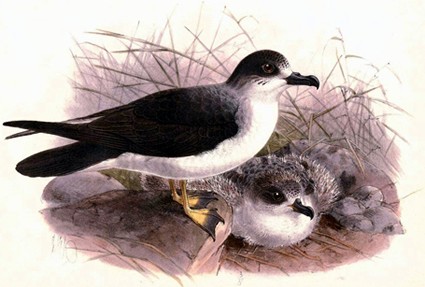
Image: F Du Cane Godman
Juan Fernandez Petrel, From Monograph of the Petrels (1909)
eating one. "One Sort [of bird] burroughs in the Earth, like Rabbits, which the Spaniards call Pardelas, and say they are good Birds. to eat; one of them flew into the Fire at our sick Mens Tent."18 Cook includes a sketch of one in his book, seen above right.
This section would not be complete without mentioning the cats. We have already seen how Selkirk tamed some of the kittens to protect him against the rats and then danced with them when he was bored, but he never seems to have regarded them as food. Nor does Cooke, who says that there are "wild Cats here, which are of several Colours, but, being of the European Kind, no more need be said of them."19 The notion of eating the cats is found in the account of the maroons from the 1720 shipwreck of the Speedwell. Captain George Shelvocke was not enthralled with the idea, explaining that there "were plenty, and esteem'd a better sort of diet, by every one but myself, who could never be perswaded to taste them"20. Like Cooke, he says they "they are in size and colour exactly the same with our house cats" and that those who could bring themselves to eat them found their flesh more filling than seals and fish.21
1,2 Jacob Le Maire, “Australian Navagations”, The East and West Indian Mirror, J.A.J. DeVilliers, ed., 1906, p. 190; 3 William Dampier, A New Voyage Round the World, 1699, p. 88-9; 4 William Funnell, A Voyage Round the World, 1969, p. 20; 5 Woodes Rogers, A Cruising Voyage Round the World, 1712, p. 132-3; 5 Basil Ringrose, The Voyages of Capt. Sharp, 1684, p. 48, Dampier, p. 88 & Nicholas Simson, Observations Made During a South-Sea Voyage, 1689, Quoted in Jonathan Lamb, Vanessa Smith & Nicholas Thomas, Exploration and Exchange: a South Season Anthology, 1680-1900, 2000, p. 34; 7 Funnell, 19 & 20; 8 Rogers, p. 131-2 & 133; 9 Edward Cooke, Voyage to the South Seas, 1712, p. 113; 10 George Shelvocke, A Voyage Round the World by Way of the Great South Sea, 1726, p. 244; 11 Jacob Roggeveen, Dagverhaal der ontdekkings-reis van Mr. Jacob Roggeveen, 1838, interpreted from Dutch by the author, p. 89-90; 12 Richard Walter, A Voyage Round the World by Way of the Great South Sea, 1726, p. 121; 13 Walter, p. 157; 14 Walter, p. 120-1; 15 Lionel Wafer, A New Voyage and Description of the Isthmus of America, 1903, p. 103; 16 Richard Simson, Observations Made During a South-Sea Voyage, 1689, Quoted in Isaac James, Providence Displayed, 1800, pp. 25; 17 Rogers, p. 131; 18,19 Cooke, p. 117; 20 Shelvocke, p. 244; 21 Shelvocke, p. 251
Cooking
Most sailors accounts only mention ways to cook things in passing, but
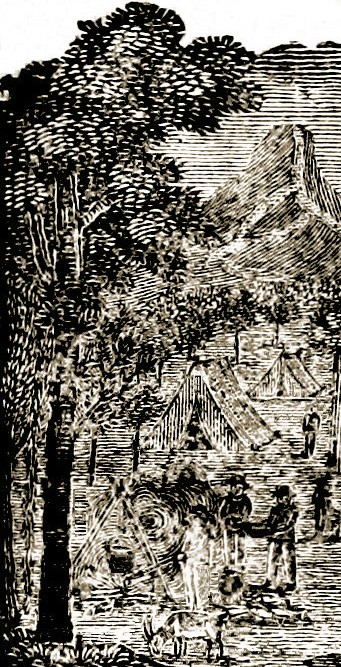
Duke and Dutchess Camp with Cooking Fire and Goat, From
Providence Displayed, By Isaac James, p. 112 (1800)
the sailor's account of visiting the Juan Fernandez islands include several comments on cooking which are worth gathering in their own section. Woodes Rogers explains how Alexander Selkirk prepared goats for those on Juan Fernandez based on his experiences while stranded there. When the Duke and Dutchess brought their ill ashore, Rogers explains that Selkirk "caught us two Goats, which make excellent Broth, mix'd with Turnip-Tops and other Greens, for our sick Men, being 21 in all"1. Rogers seemed particularly impressed with how well the broth made with Juan Fernandez goat's meat tasted, mentioning a second time how 'very good' the broth was because the goats were not 'as rank as ours'. He further says that Selkirk sometimes boiled goat's mean and at other time broiled it, presumably on the boucain (barbeque grill) he made there.2 Sailor William Funnel explained that "a joint of one of them roasted, with about half a foot of Cabbage boiled, makes a very good meal."3 Rogers also notes that Selkirk both boiled and broiled lobsters he caught in the bay.
While explaining how the shipwreck sailors survived on Más a Tierra, George Shelvocke details the manner in which fish were prepared: "Our fish we fry'd in seals oil, without salt, or any thing of bread kind to eat with it, or ought else but a little wild sorrel."4 Sorrel has a tangy, acidic flavor which would likely complement most fresh fish, lacking anything else to flavor it.
Sea lions were eaten by some of the ships who stopped at the Juan Fernandez Islands as explained, but the had another use for period sailors - to produce oil from their blubber. Woodes Rogers said that they refined and strained seal oil for use in lamps. He added, "Sailors some times use it to fry their Meat, when straiten'd for want of Butter, &c. and say 'tis agreeable enough."5 Dampier advised that the oil "is very sweet and wholsom to fry Meat withal."6 Shelvocke likewise said they fried their fish is seal oil.7 Even the Spanish who briefly settled on the island made use of sea-lion oil according to Chilean priest and historian Diego de Rosales. In his history of the country, he explains that "when the island was populated, the Spaniards had a good farm which processed oil and sent it to Peru, which they could easily take, because leaving a quarter of the sea lion hanging out in the sun would distill the oil"8.
1 Woodes Rogers, A Cruising Voyage Round the World, 1712, p. 131; 2 Rogers, p. 126; 3 William Funnell, A Voyage Round the World, 1969, p. 20; 4 George Shelvocke, A Voyage Round the World by Way of the Great South Sea, 1726, p. 245; 5 Rogers, p. 131; 6 William Dampier, A New Voyage Round the World, 1699, p. 90; 7 Shelvocke, p. 245; 8 Diego de Rosales', Historia general de el reyno de Chile, 1877, translated by the author, p. 307

